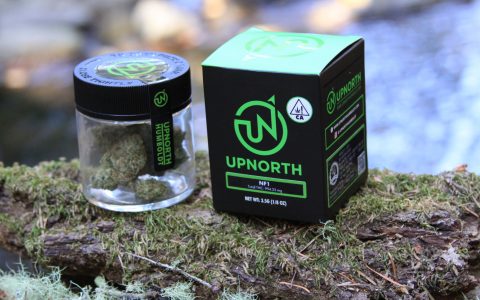No need for a spoiler alert, because I haven’t yet watched Murder Mountain, a new true crime docu-series that promises to peel back the Redwood Curtain, revealing the violence and mayhem that lies at the heart of Humboldt County, California—a.k.a. “Weed Country.”
If you’re in search of a comprehensive review and breakdown of Murder Mountain, stay tuned for a follow-up story by Leafly’s Will Hyde.
But what a shame it would be if a grisly homicide becomes the first thing people think of when they think of Humboldt County.
For the rest of us, all you need to know is that the six-part series begins with a tale of murder most foul that took place up in the mountains. And that when local police showed little interest in investigating yet another mysterious disappearance in California’s leading locality for missing persons, a vigilante group took matters into their own hands.
Which, it turns out, was just one of a string of similarly disturbing cases to spring up in the remote wilderness around Alderpoint, California (population 186) over the last few decades.
Apparently, murder is nothing new on Murder Mountain.
But what a shame it would be if a grisly homicide becomes the first thing people think of when they think of Humboldt County. Especially right now, as Northern California’s famed “Emerald Triangle” is struggling to redefine itself as a tourist-friendly “appellation of origin” for craft cannabis, even as tight new cultivation regulations are effectively pulling the rug out from under much of the local economy.
Now, to their credit, the producers of Murder Mountain apparently went to great lengths to talk with a wide range of community members, while weaving together a detailed backstory that explains how, over the last half century, Humboldt transformed from a counterculture haven to a magnet for dangerous criminals looking to get rich or get high trying.
And while it may be tempting to dismiss the very notion of “Murder Mountain” as sensationalistic media hype, that’s actually a name the locals came up with.
Still, as Leafly’s Cannabis Traveler’s Guide makes clear, there’s a lot more to Humboldt County than all that unpleasantness. Like hiking, fishing, beaches, incredible food, culture, art, and oh yeah—some of the finest cannabis on earth, grown by the most legendary cultivation community this side of Morocco.
Back to the Garden
So how did Humboldt become synonymous with cannabis?
In search of self reliance in the style of Henry David Thoreau and an escape from “square society,” the first generation of Humboldt’s world famous outlaw cannabis growers started showing up in the 1960s—hippies and seekers who bought up cheap land after the big fisheries cut bait and the timber companies chopped down all the profitable trees. Dubbed back-to-the-landers by their admirers, and “hippie dipshits” by a fair number of the locals, they set up homesteads that often included a hidden patch of pot plants to cover their head stash and help make ends meet.
For a brief moment in time, it was an idyllic life. Then came the war on weed, a true military-level operation, complete with armed helicopter raids and relentless, ruthless enforcement. All of which skyrocketed the price of an outdoor pound, while sending a lot of the OG small-time peacenik growers scurrying for cover.
Into that lucrative vacuum flowed biker gangs, organized crime syndicates, and drug cartels, who see cannabis as a cash crop, not a true calling.
Into that lucrative vacuum flowed biker gangs, organized crime syndicates, and drug cartels, who see cannabis as a cash crop, not a true calling.
That’s when growers started getting a bad reputation for spilling diesel, sporting firearms, poisoning wildlife, diverting rivers, clearcutting land, and scaring the shit out of their neighbors—or worse. That’s also when locals started calling hundred-dollar-bills “Humboldt twenties.”
A Look From the Inside
Chris Durant remembers those heady days well. He logged eight years as the crime reporter at the Times-Standard in Eureka. Now he runs a humor magazine called Savage Henry that’s a favorite among Humboldt cannabis growers. And he just opened the first-ever comedy club in the county.
He knows the lay of the land up there as well as anyone (if not exactly where the bodies are buried).
“I stopped watching anything about Humboldt a long time ago, because nobody ever gets it right,” Durant tells me, though he says friends who’ve seen Murder Mountain seem to like it. “I’m not personally worried about whether or not people come up here, but if they do, they should have their eyes open. Every place has its dangers, so just don’t blow it out of proportion.”
I’ve been a fan of Savage Henry since my first trip (of many) to Humboldt County, about ten years ago, when I fell in love with this hidden and misunderstood part of the world.
I made that first pilgrimage to pay a visit to a few friends and help them trim an alleged ton of weed. They grew their crop off-the-grid, slept in tents, cooked on a propane camp stove, and through a mix of new age idealism and economic necessity, managed to live a fairly back-to-the-land type existence—though they were sharecroppers not homesteaders.
My experience was marked by joy, new friends, and learning a lucrative trade, but for other trimmers, the shadow of the illicit market has masked abusive and dangerous working conditions, ripoffs, and worse.
Just three of them tended to the farm during the summer, but at harvest time, they brought in about two dozen reinforcements to help with cutting down the plants, and drying, trimming, and curing the buds in a timely fashion—all part of a huge undocumented transient labor force of “trimmigrants” that flocks to Humboldt every autumn.
My personal experience was marked by great joy, new friends, and learning a lucrative trade, but for other trimmers, the dark shadow of the illicit market has masked abusive and dangerous working conditions, ripoffs, and worse.
Cannabis Heaven or Pot Purgatory?
At the time, however, I was young and naive and had no sense of a dark aura up in the hills. At our little grow scene, and many others, it was more like a summer camp that paid in cash. We did yoga in the mornings, ate communal vegan casseroles for dinner, bathed in the river with Dr. Bronner’s soap, peed freely in the gender-neutral woods behind the drying shack, and went #2 in a well-maintained composting toilet, which boasted an incredible view of the surrounding wilderness.
On my first morning, as I reached for a roll of scratchy unbleached toilet paper, I found a weathered stack of Savage Henry’s next to the tin can of sawdust and ash provided to cover over our leavings. Written by locals and intended for a local audience, the magazine’s humor is a mix of tragedy and comedy that reflects the woke heart and battered soul of Humboldt itself.
Those disappearances aren’t the result of legalization—prohibition pushed cannabis into the shadows, replacing the weed heads with greed heads willing to use violence to protect their bottom line.
Through their sharp satire and absurdist lampooning, I discovered that while the Emerald Triangle is still home to plenty of weed-growing open-hearted hippies like the lot I’d fallen in with, there’s also a menacing meth-y side of things that’s been leading to trouble since long before the world premiere of Murder Mountain.
So is Humboldt County cannabis heaven or pot purgatory?
Murder Mountain’s tagline would have you believe that “the big business of legal marijuana brings in visitors from around the world. Some are never seen again.”
But those disappearances aren’t the result of legalization—they stem from a long, dark history of prohibition that pushed the cannabis economy into the shadows, replacing the weed heads with greed heads willing to use violence to protect their bottom line. Think of it this way: There’s a reason Wine Country doesn’t have its own Murder Mountain.
“I’ve covered some pretty gruesome killings in Humboldt, and only rarely did they have anything to do with the weed industry,” Durant explains. “That said, don’t come up here and start trespassing on people’s private property or getting mixed up in situations that aren’t safe. But also keep in mind that Humboldt isn’t the only place with problems.”
So don’t be scared of Humboldt County, come experience it for yourself.
I promise that unless you decide to try to flip a few pounds of Trainwreck while you’re passing through, it’s exceedingly unlikely you’ll end up getting murdered.







